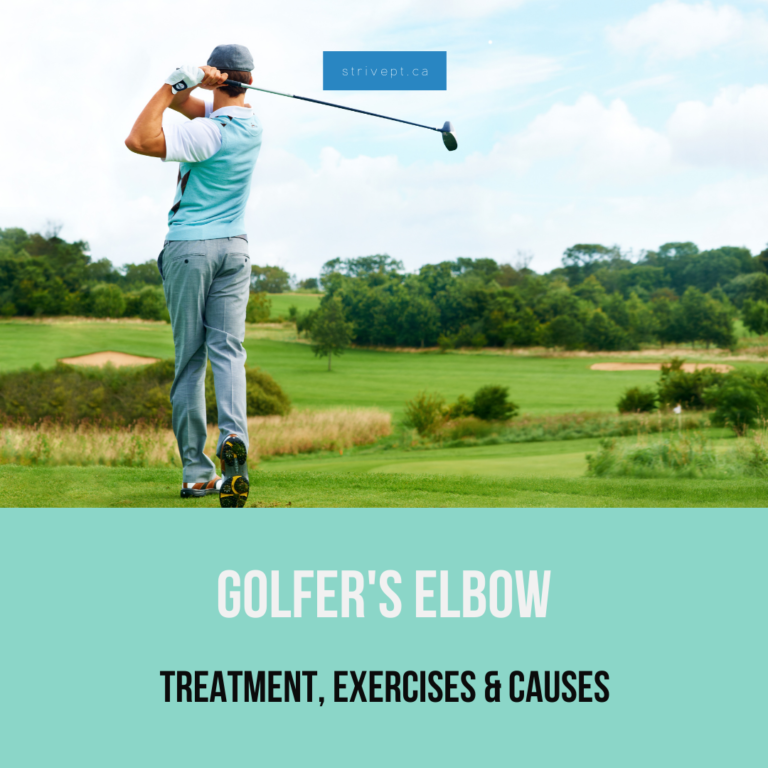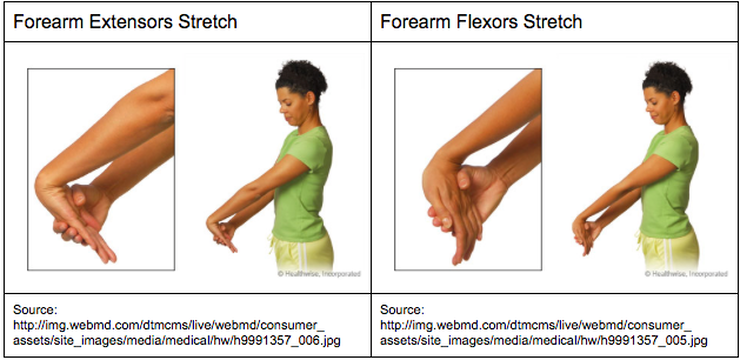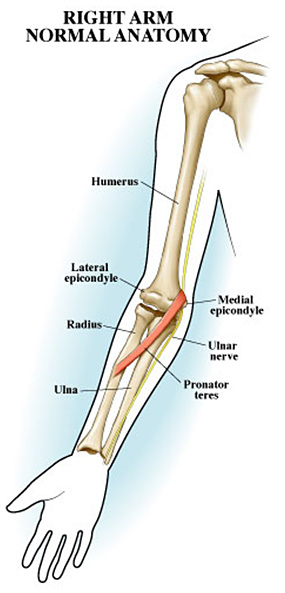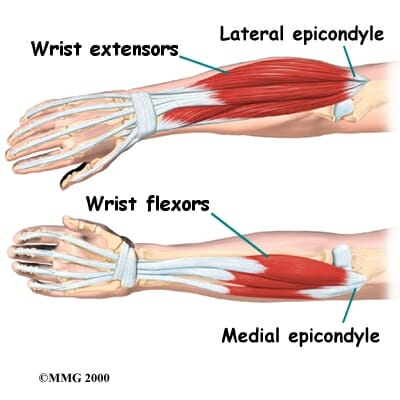
Many people with elbow pain on the inside of their elbow get diagnosed with golfer’s elbow, and are left confused because they’ve never played more than their local mini-putt! Read on, and I’ll clear up the confusion, explain why some people get it, and a few things you can do to help it.
What is Golfer’s Elbow?
Golfer’s elbow is the layman’s term for a tendinopathy at the medial epicondyle. Tendinopathy means a pathology in a tendon (the structure that connects muscle to bone!). Medial epicondyle is the bony location that the irritated tendon inserts on.
You may be more familiar with the term “medial epicondylitis”, which is still prevalent in society, social media, and possibly even with your health care practitioner! The suffix “-itis” indicates inflammation, so medial epicondylitis means “inflammation of the medial epicondyle”.
However, inflammation can’t be identified specifically as the cause of the injury or pain (sometimes inflammation isn’t even present!), and the structures that are irritated are actually the tendons that attach to the medial epicondyle (not the bone itself), so do you see how this name doesn’t really make a lot of sense? Okay, faulty nomenclature lesson over!
Here’s a brief anatomy review:
Look at the above picture. Your humerus (upper arm bone), ulna (forearm bone), and radius (your other forearm bone), come together to make up the elbow joint. The medial epicondyle is the bony protrusion on the distal part of your humerus on the inside of your elbow.
The picture above shows the muscles on the front of your forearm. These muscles are called flexor muscles because they function to flex the wrist and fingers.
Most of the flexor muscles combine into one tendon and attach to the medial epicondyle. This tendon is often called the common flexor tendon.
Golfer’s elbow is an irritation of the common flexor tendon (which attaches to the medial epicondyle bone).
But How Did I Get It? I’ve Never Played the Sport!
Golfer’s elbow is named this way because it’s common for those who play golf to experience pain on the inside of their elbow. They get this pain by overusing their forearm flexor muscles during their golf club swing.
But there’s many people with this condition that have never played golf! People usually get golfer’s elbow by overusing their forearm muscles, often with repetitive activity. For example, people that do lots of hammering, forceful work with your hands, gripping or lifting heavy things, or even typing on a keyboard!
Typically, these injuries develop over time, and get gradually worse. Straining the muscles over and over again puts too much stress on the tendons, and results in the inability to recover fully before being loaded again. There may (or may not) be an inflammatory component that contributes to local tissue irritation as well after being overloaded repetitively.
Commonly, people with these injuries feel pain with gripping/lifting objects, opening doors, or even shaking hands. More importantly, it usually hurts to do the activity that caused the problem in the first place!
Acute Wrist Flexor Injury
Some people may have an acute episode of pain that happens when you suddenly and dramatically increase the amount that you are using your wrist flexor muscles and tendons in a short period of time (ie. building a deck on the weekend when you usually don’t do manual labour). It may be very painful for a short period of time while it recovers, but it also may go away more quickly if you usually don’t overload your tendons like that.
You will want to rest from your aggravating activities (ie. stop building the deck or leave it for a weekend), and bend and straighten your wrist and elbow throughout the day to keep it moving gently. When you can do so comfortably, you can start stretching your wrist flexor muscles and tendons to regain full motion.
The stretch is simple, and can be completed anywhere. The pictures below show how to stretch the muscles on the front of your forearm (flexors). Hold the stretch (should not be painful!) for 30 seconds, and do 3 repetitions of each stretch 2-3 times a day.

But This Has Been Bothering Me For A While… “Wait and See” Didn’t Work… What Can I Do About It?
Like most injuries, it’s a great idea to try and prevent any occurrence in the first place. Resting from repetitive activity, even before the onset of pain, can help limit the development of golfer’s elbow. Further, maintaining a good overall fitness, and good forearm strength can be helpful.
If you unfortunately already have symptoms of golfer’s elbow, physiotherapy can be very helpful. Common strategies used at physiotherapy to help manage these conditions include:
- Relative Rest
Most people with Golfer’s Elbow can identify activities that aggravate their symptoms, or identify activities that may have repetitively overused their wrist and finger flexor muscles. You may need to temporarily decrease, or eliminate, these activities depending on how severe your symptoms are. If you’re not sure, a Registered Physiotherapist can help you determine what may be contributing to your symptoms, and help troubleshoot ways to prevent aggravating your symptoms while you work on your recovery plan.
- Gentle motion
If your elbow is already really painful, you many need to do some gentle range of motion throughout the day to help keep it feeling loose. Bend and straight your elbow 10 times, and then bend your wrist forward and back comfortably 10 times, 5 times per day. This will help get some gentle motion in your tissues that are irritated, and will help calm it down. Don’t push through pain with these – keep it quite comfortable.
Check out the video below to see these exercises.
- Bracing (One good one is called a ‘Band-IT’ brace, you can buy one from Amazon for $40).
The purpose of the brace is to offload the tendon that is irritated by creating a different origin for the flexor muscles. The brace will be quite tight in order to limit the pulling on the tendon on the inside of your elbow. However, this brace still allows you to use your flexor muscles, with the benefit of decreased or eliminated pain. The brace should be used anytime you might be gripping, using your hands, or with any activities that are typically painful.
- Manual therapy and massage therapy.
The goal with any hands on treatment is to decrease pain and improve the mobility of the muscles and tendons. This will help you be able to do your exercises more comfortably, and do your desired daily activities with less pain. There are many types of manual therapy and massage therapy that you may find beneficial to take the edge off of the pain.
- Acupuncture, TENS, or other pain relief modalities
There are many different treatments that can provide a temporary relief in pain as you are trying to get your Golfer’s Elbow to calm down. A small window of pain relief can help take that first step towards being able to do exercises to get it better. If pain is severe, some people find ice is helpful initially. As you recover, a heating pad may be more beneficial to relax the muscles that are tight and bring blood flow to the area to allow easier movement.
- Strengthening
Really, I saved the best for last. If you don’t remember anything else, strengthening your wrist/finger flexors is THE MOST IMPORTANT THING TO REMEMBER. You may find it difficult to recover fully to 100% if you don’t progressively strengthen (AKA load) your wrist and finger flexors. Progressive loading means that even if you can’t lift heavy weights right now or grip really hard NOW, you start at a manageable level of exercise and move on to more difficult exercises/weights/resistance as you go. You will need to build your muscles up to tolerate MORE than the load that you usually need to use in your daily life.For example, someone who does manual labour with tools for 8 hours every day may need to work harder and for longer on strengthening than someone who types on a computer for a few hours per day.A great place to start is by doing eccentric exercises. Some people find that these are more comfortable to start with. An eccentric exercise means your muscle is contracting, but lengthening at the same time. For an Eccentric Wrist Flexion with a Dumbell exercise, you are going to have your forearm resting on a surface with a small dumbbell in your hand with your palm facing the ceiling. You are going to use your opposite hand to pull your hand and dumbbell up, and then use your injured arm to lower the weight back down. Repeat 3 sets of 15 repetitions is possible, 1x/day. Slow it down! Try to take 5 seconds to lower the weight down. Start with a very light weight that causes less than 2/10 pain intensity. If there is no pain or discomfort, then increase the weight of the dumbbell. Any pain that results from this exercise should be manageable, and be gone within 24 hours.
Check out the video below to see how to do this!
Once you are able to comfortably, we can add the concentric part of the wrist curl back in. This means that your injured side will bring the weight up as well as lower it back down. You can continue doing 3×15 of this version as well on a daily basis. If you are getting into heavier weights as your recovery progresses, and especially if you start performing aggravating activities again, you can perform this exercise every other day.
Check out the video below to see the full Wrist Flexion with a Dumbbell exercise.
Okay I’m in, I’ll do it! How long am I going to have to do this for?
Unfortunately, especially when you’ve had Golfer’s Elbow for a while, it can take months to recover (or even up to a year!). And that’s WITH working on it regularly.
I recommend continuing to work on the strengthening exercises until well after you feel 100%, and even maintaining a little routine of this exercise 2-3x/week on a regular basis to maintain the health of the tendons.
Some individuals that regularly overload their tendons and are not able to rest them at all may struggle to manage this condition over a period of years. With the above recommendations, you should be able to manage your pain well and keep your function up.
You may find that there are other movements that bother you as well. The above exercise program is a good place to start, but a physiotherapist can fully assess your condition and your work/activity requirements and create a personalized exercise program.
Still Concerned?
Not sure if you have Golfer’s Elbow, or concerned about your elbow pain in general? Want to get out of pain, and back to function? The best thing to do is to see a physiotherapist and get your elbow assessed as soon as possible.
At Strive Physiotherapy & Performance, we are committed to providing an in-depth assessment to ensure we can work together to find the best plan of action for each individual client. Call us at 519-895-2020, or use our online booking tool on www.strivept.ca to book an appointment with one of our knowledgeable physiotherapists, and they will be sure to help you understand your injury.
Thanks for reading,
Amanda McFadden
Physiotherapist at Strive Physiotherapy & Performance

